SpringBoot는 클라이언트가 제출한 데이터/매개변수를 받을 때 관련 설명을 사용합니다.
@PathVariable, @RequestHeader, @ModelAttribute, @RequestParam, @MatrixVariable, @CookieValue, @RequestBody
1. 요구 사항: 데이터/파라미터를 서버에 제출하는 다양한 방법과 서버가 이를 수신하기 위해 어떻게 Annotation을 사용하는지 시연
2. 적용 예시 시연
요구사항: 데이터를 제출하는 다양한 방법 시연 /parameters를 서버에 추가하고 서버가 이를 사용하는 방법 주석 수신
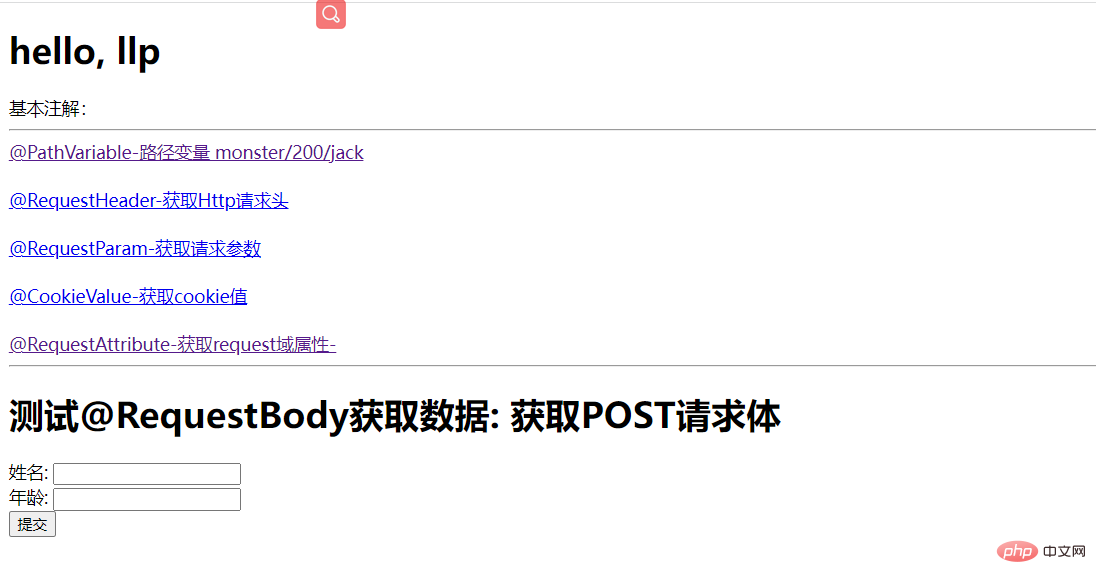
Create srcmainresourcesstaticindex.html
<!DOCTYPE html>
<html lang="en">
<head>
<meta charset="UTF-8">
<title>index</title>
</head>
<body>
<h2>hello, llp</h2>
基本注解:
<hr/>
<a href="/monster/200/jack" rel="external nofollow" >@PathVariable-路径变量 monster/200/jack</a><br/><br/>
</body>
</html>Demo @PathVariable 사용, srcmainjavacomllpspringbootcontrollerParameterController.java 생성, 테스트 완료
@RestController
public class ParameterController {
/**
* /monster/{id}/{name} 解读
* 1. /monster/{id}/{name} 构成完整请求路径
* 2. {id} {name} 就是占位变量
* 3. @PathVariable("name"): 这里name 和{name} 命名保持一致
* 4. String name_ 这里自定义,和{name}命名无关
* 5. @PathVariable Map<String, String> map 把所有传递的值传入map
* 6. 可以看下@PathVariable源码
*/
@GetMapping("/monster/{id}/{name}")
public String pathVariable(@PathVariable("id") Integer id,
@PathVariable("name") String name,
@PathVariable Map<String, String> map) {
System.out.println("id-" + id);
System.out.println("name-" + name);
System.out.println("map-" + map);
return "success";
}
} 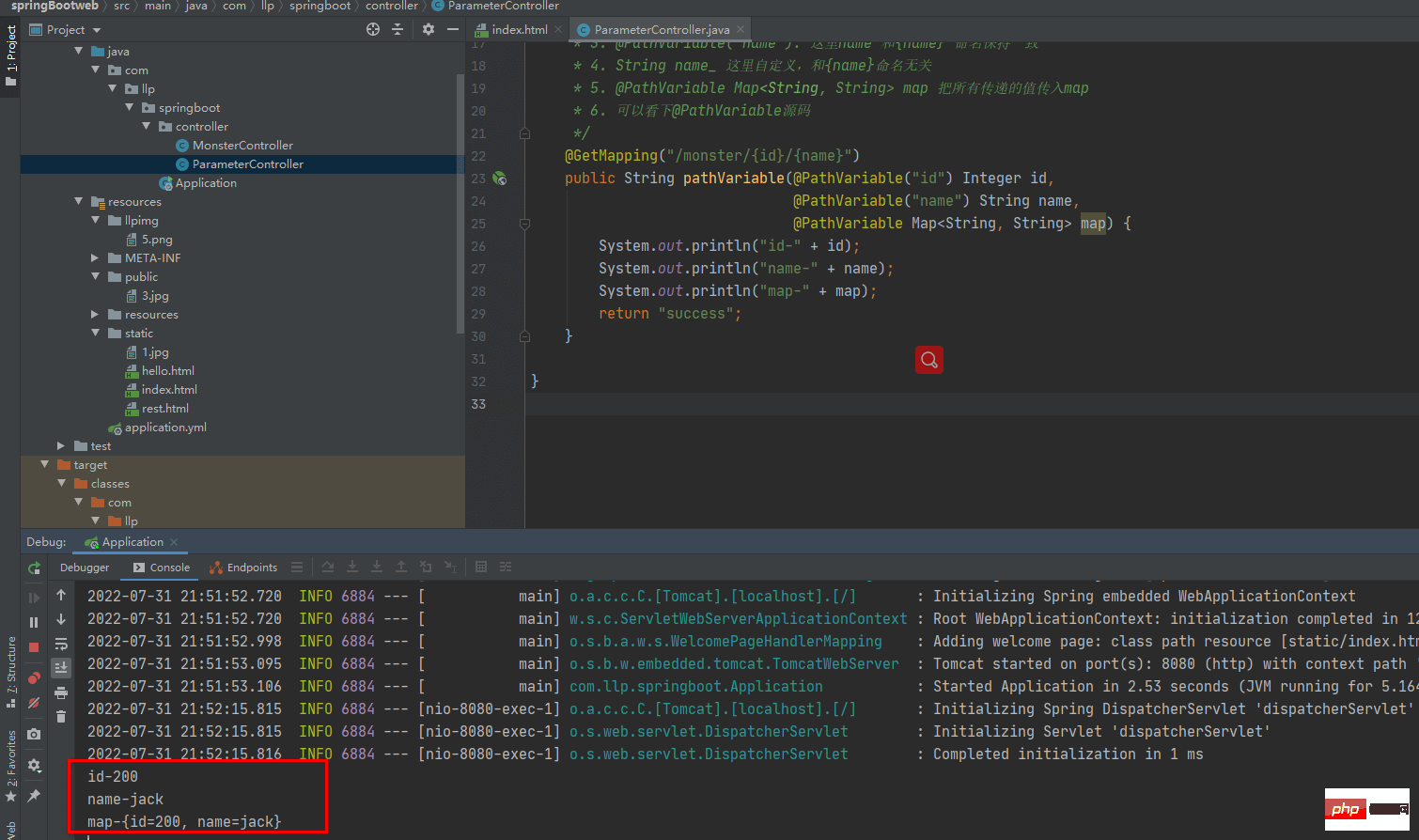
를 사용하여 @RequestHeader를 수정하고 테스트
√ ParameterController.java
<a href="/requestHeader" rel="external nofollow" >@RequestHeader-获取Http请求头 </a><br/><br/>
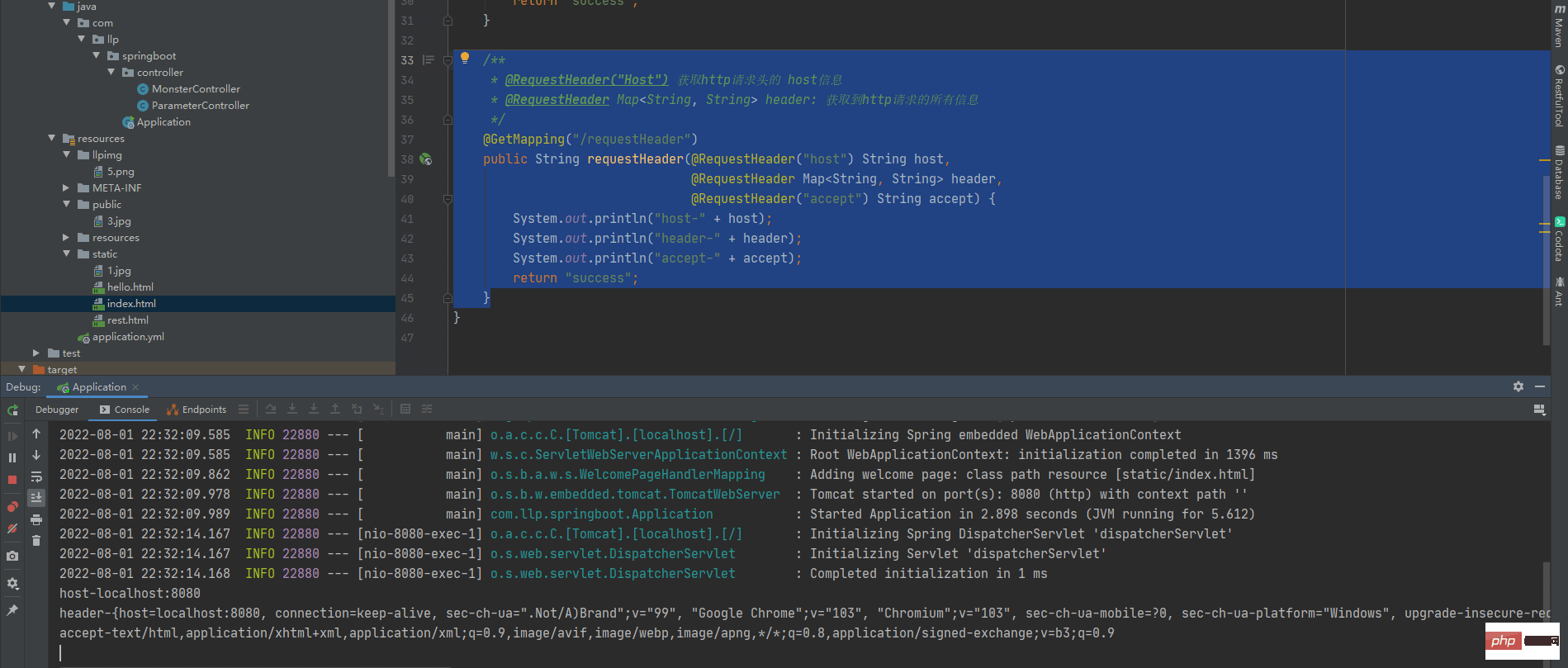 @RequestParam 사용 데모 @RequestParam 사용, ParameterController.java 수정, 테스트 완료
@RequestParam 사용 데모 @RequestParam 사용, ParameterController.java 수정, 테스트 완료
/**
* @RequestHeader("Host") 获取http请求头的 host信息
* @RequestHeader Map<String, String> header: 获取到http请求的所有信息
*/
@GetMapping("/requestHeader")
public String requestHeader(@RequestHeader("host") String host,
@RequestHeader Map<String, String> header,
@RequestHeader("accept") String accept) {
System.out.println("host-" + host);
System.out.println("header-" + header);
System.out.println("accept-" + accept);
return "success";
}√ 수정 ParameterController.java
<a href="/hi?name=wukong&fruit=apple&fruit=pear&id=300&address=北京" rel="external nofollow" >@RequestParam-获取请求参数</a><br/><br/>
@CookieValue 수정 @CookieValue 사용을 보여주기 위해
사용 , 테스트를 완료하세요
/**
* @param username wukong
* @param fruits List<String> fruits 接收集合 [apple, pear]
* @param paras Map<String, String> paras 如果我们希望将所有的请求参数的值都获取到,
* 可以通过@RequestParam Map<String, String> paras这种方式
* 一次性的接收所有的请求参数 {name=wukong, fruit=apple, id=300, address=北京}
* 如果接收的某个参数中有多个之值比如这里fruits是一个集合,从map中只能拿到一个
* 可以理解map底层会将相同的key的value值进行覆盖
* @return
* @RequestParam
*/
@GetMapping("/hi")
public String hi(@RequestParam(value = "name") String username,
@RequestParam("fruit") List<String> fruits,
@RequestParam Map<String, String> paras) {
//username-wukong
System.out.println("username-" + username);
//fruit-[apple, pear]
System.out.println("fruit-" + fruits);
//paras-{name=wukong, fruit=apple, id=300, address=北京}
System.out.println("paras-" + paras);
return "success";
}√ ParameterController.java
<a href="/cookie" rel="external nofollow" >@CookieValue-获取cookie值</a><br/><br/>
@RequestAttribute를 수정하고 @SessionAttribute를 사용하세요.
Demo @RequestAttribute @SessionAttribute를 사용하고 com/hspedu/web/controller/RequestController.java를 생성하세요.
√ index.html
/**
* 因为我的浏览器目前没有cookie,我们可以自己设置cookie[技巧还是非常有用]
* 如果要测试,可以先写一个方法,在浏览器创建对应的cookie
* 说明 1. value = "cookie_key" 表示接收名字为 cookie_key的cookie
* 2. 如果浏览器携带来对应的cookie , 那么 后面的参数是String ,则接收到的是对应对value
* 3. 后面的参数是Cookie ,则接收到的是封装好的对应的cookie
*/
@GetMapping("/cookie")
public String cookie(@CookieValue(value = "cookie_key", required = false) String cookie_value,
HttpServletRequest request,
@CookieValue(value = "username", required = false) Cookie cookie) {
System.out.println("cookie_value-" + cookie_value);
if (cookie != null) {
System.out.println("username-" + cookie.getName() + "-" + cookie.getValue());
}
System.out.println("-------------------------");
Cookie[] cookies = request.getCookies();
for (Cookie cookie1 : cookies) {
System.out.println(cookie1.getName() + "=>" + cookie1.getValue());
}
return "success";
}<hr/>
<h2>测试@RequestBody获取数据: 获取POST请求体</h2>
<form action="/save" method="post">
姓名: <input name="name"/> <br>
年龄: <input name="age"/> <br/>
<input type="submit" value="提交"/>
</form>3. 복잡한 매개변수
1. 기본 소개
SpringBoot는 클라이언트 요청에 응답할 때 복잡한 매개변수도 지원합니다.
Map, Model, Errors/BindingResult, RedirectAttributes, ServletResponse, SessionStatus, UriComponentsBuilder, ServletUriComponentsBuilder, HttpSession
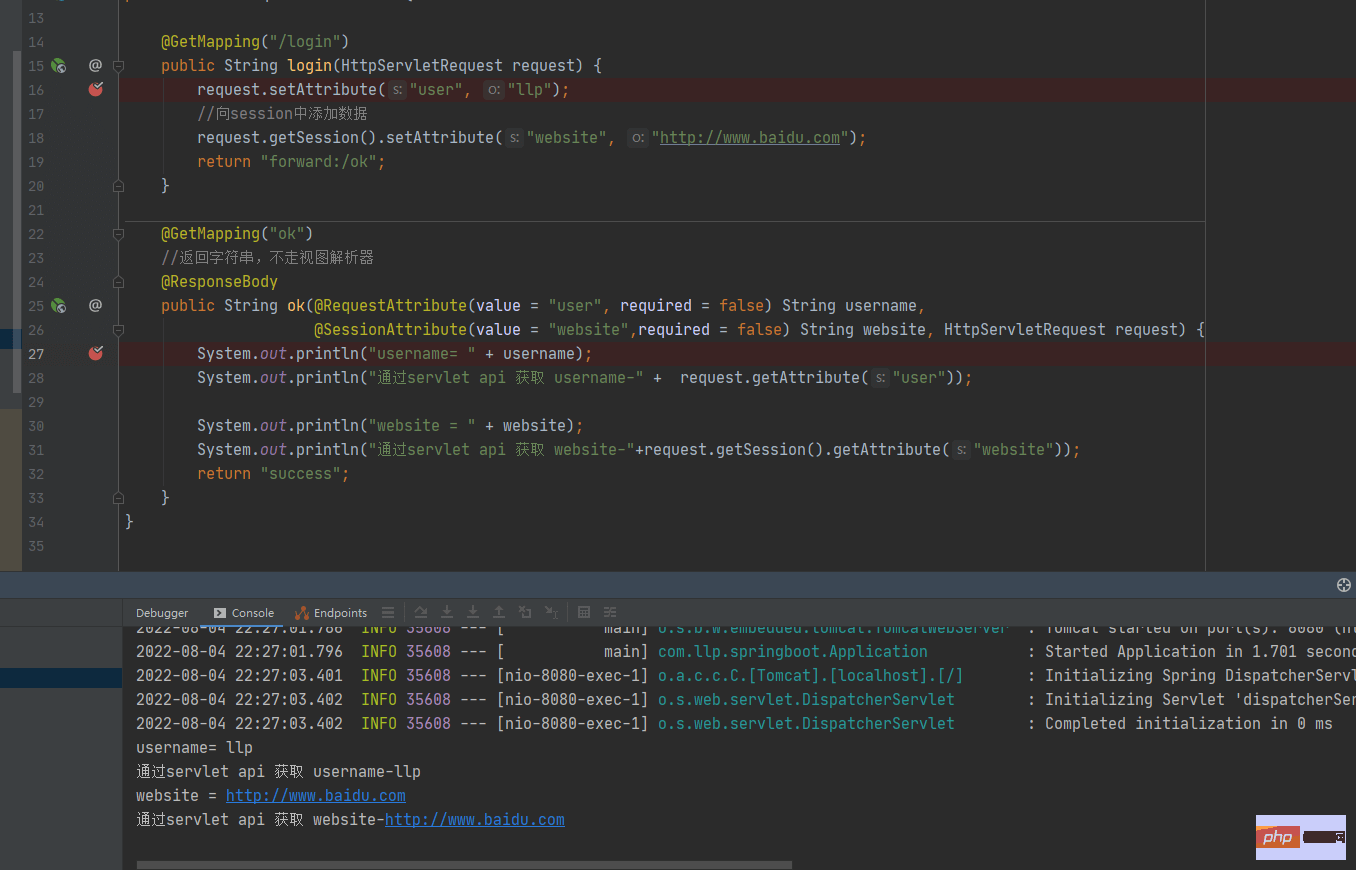
/**
* @RequestBody 是整体取出Post请求内容
*/
@PostMapping("/save")
public String postMethod(@RequestBody String content) {
System.out.println("content-" + content);
return "success";
}1. 기본 소개
를 지원하여 자동 유형 변환 및 서식 지정을 완료합니다.
캐스케이드 패키징 지원 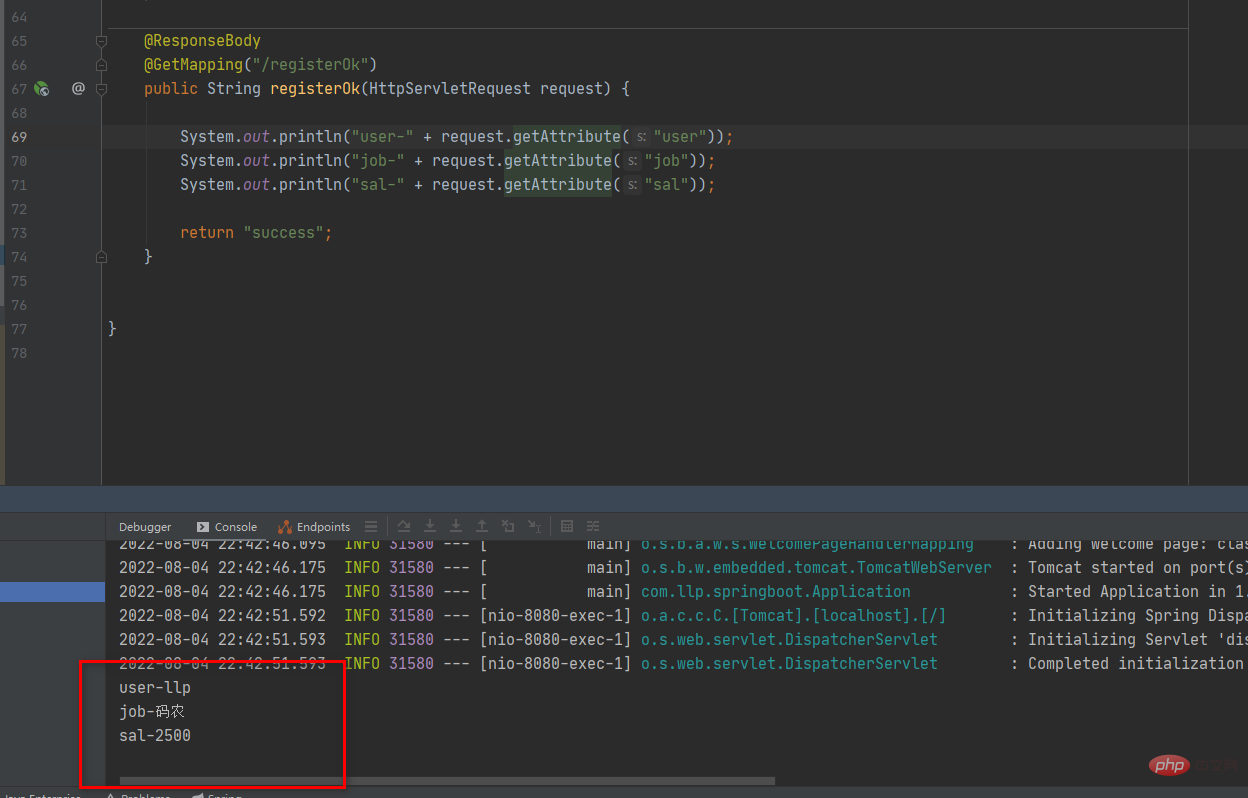
<a href="/login" rel="external nofollow" >@RequestAttribute、@SessionAttribute-获取request域、session属性-</a>
2를 생성합니다. 2. srcmainjavacomllpspringbootcontrollerParameterController.java
@GetMapping("/login")
public String login(HttpServletRequest request) {
request.setAttribute("user", "llp");
//向session中添加数据
request.getSession().setAttribute("website", "http://www.baidu.com");
//这里需要使用forward关键字,如果不适用则会走视图解析器,这
//里视图解析器前缀配置的是/ 后缀配置的.html ---> /ok.html
//而请求转发在服务器端执行,/被解析成 ip:port/工程路径
//进而最终得到的完整路径是 ip:port/工程路径/ok.html
//但是我们这里希望访问的是 ip:port/工程路径/ok这个请求路径
//因此这里手动的设置forward:/ok ,底层会根据我们设置的路径进行请求转发
return "forward:/ok";
}
@GetMapping("ok")
//返回字符串,不走视图解析器
@ResponseBody
public String ok(@RequestAttribute(value = "user", required = false) String username,
@SessionAttribute(value = "website",required = false) String website, HttpServletRequest request) {
System.out.println("username= " + username);
System.out.println("通过servlet api 获取 username-" + request.getAttribute("user"));
System.out.println("website = " + website);
System.out.println("通过servlet api 获取 website-"+request.getSession().getAttribute("website"));
return "success";
}
}을 수정합니다.
위 내용은 매개변수를 수신하기 위해 SpringBoot가 사용하는 주석은 무엇입니까?의 상세 내용입니다. 자세한 내용은 PHP 중국어 웹사이트의 기타 관련 기사를 참조하세요!